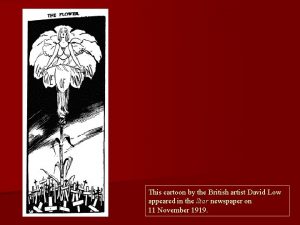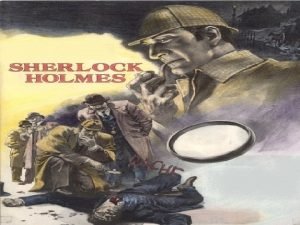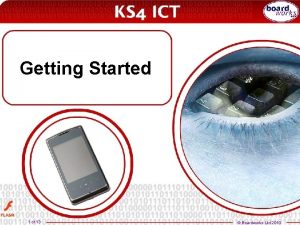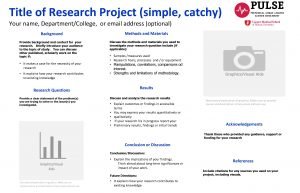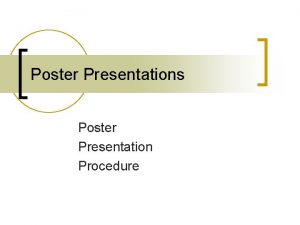This presentation originally appeared online a http presentations












































- Slides: 44

This presentation originally appeared online a http: //presentations. Scary. Little. Airplanes. org. This site has been suspended however. It is reproduced here therefore. Who originally created it is not known. Please view all after Washington ADIZ.

Flying in Special Use Airspace üFlying around Washington D. C. üFlying in Presidential TFR’s. üLost Procedures üIntercept Procedures

Disclaimer ü The information contained in this presentation will become obsolete. ü Information in this presentation may be wrong. ü Your presenter, while well meaning, may be completely out to lunch, if not a complete idiot. ü The use of deadly force has been authorized. Get a briefing before EVERY flight!!! 1 -800 -WX-BRIEF

Topics to Cover ü Flying Around Washington D. C. ü Flying in Presidential TFR’s ü Lost Procedures ü Intercept Procedures An electronic copy of this presentation will be available at: • http: //presentations. Scary. Little. Airplanes. org

Washington D. C. Airspace üFlying into the ADIZ üDeparting from the ADIZ üPattern Work in the ADIZ üVisual Warning System üOther ADIZ Information

The Washington D. C. Area

Parts of Special D. C. Airspace ü Flight Restricted Zone § Also called the “Special Flight Rules Area”. § Generally speaking, you may not operate within the Flight Restricted Zone. ü Air Defense Identification Zone § Generally, operations in the ADIZ are subject to the following conditions: • An NAS flight plan must be filed on the ground. • The flight plan must be activated (with ATC). • You must be squawking an a discrete transponder code. § There are exceptions to the above.

ADIZ Entry Requirement #1 Flight Plans ü Prior to operating an aircraft in the DC ADIZ, pilots must: § File their flight plan with an AFSS. § Activate their flight plan prior to departure or entering the DC ADIZ. § Close their flight plan upon landing or leaving the DC ADIZ.

ADIZ Entry Requirement #2 Communications with ATC ü Your aircraft must be equipped with an operable two-way radio capable of communicating with ATC on appropriate radio frequencies. ü The flight crew must establish two-way radio communications with the appropriate ATC facility before operating in this ADIZ and the flight crew must maintain the capability of continuing two -way radio communications with the appropriate ATC facility while operating in this ADIZ. § Aircraft operating in an airport traffic pattern at non-towered airports are exempt from the ATC communication requirements, provided they monitor the airport CTAF.

ADIZ Entry Requirement #3 Transponders ü The aircraft is equipped with an operating transponder with automatic altitude reporting capability as specified in 14 CFR section 91. 215. ü Prior to operating the aircraft in the ADIZ, the flight crew obtains a discrete transponder code from ATC. ü The Aircraft’s transponder continuously transmits the ATC issued discrete transponder code while the aircraft is operating in this ADIZ.

ADIZ Entry Requirement #4 Airspace ü The flight crew, prior to operating within Class B, C or D airspace that is within the ADIZ must receive a separate ATC clearance to enter the Class B, C or D airspace. ü Class B § Get a normal clearance in addition to ADIZ procedures. ü Class D § Establish two-way radio communications, as normal, in addition to ADIZ procedures. ü Restricted Airspace § Stay out. ü Prohibited Airspace § Stay out. ü Flight Restricted Zone § Stay out.

Flying VFR into the ADIZ ü File an NAS Flight Plan § Specify that you are penetrating the Washington D. C. ADIZ. § File the route that you intend to fly. ü Prior to entering the ADIZ: § Contact Potomac Approach and request a “discrete transponder code for ADIZ penetration. § Squawk the appropriate code, and listen for “RADAR Contact”. § Continue squawking the code until you are on the ground or clear of the ADIZ. ü Close your flight plan with FSS. “Potomac Approach, this is Warrior 8321 H, ten miles southwest of Lancaster VOR level 2, 000 feet, with an ADIZ flight plan on file for Gaithersburg. Request discrete transponder code for ADIZ penetration. ”

Landing or Transitioning? ü Landing in the ADIZ? § You will be “handed off” to CTAF or tower when near the destination airport. § Continue squawking your code until you are on the ground. § Close your flight plan with the correct FSS!!! ü Transitioning the ADIZ? § You will be advised when you are clear of the ADIZ. § Don’t forget to close your flight plan with the correct FSS!!!

Departing VFR from within the ADIZ ü File an NAS Flight Plan § Specify that you are penetrating the Washington D. C. ADIZ. § File the route that you intend to fly. ü Activate the NAS Flight Plan through: § Clearance Delivery, or § Flight Services RCO, or § 1 -800 -WX-BRIEF ü While departing: § Set your transponder code, and put the transponder in “ALT” mode. § From a Towered Airport, talk to tower until handed off to Potomac Approach. § From a non-towered airport, talk to CTAF and change to approach as soon as possible. ü Close your flight plan with FSS when appropriate.

Fringe Airports ü There are special departure rules for the following “fringe” airports: § § § Airlie Albrecht Harris Martin State Meadows Mylander Stewart St. John Tilghman Whipp Upperville Wolf ü Departure Checklist § No flight plan required. § Squawk 1205. § Use CTAF to announce your departure. § Monitor Potomac Approach. § Exit the ADIZ by the most direct route possible while: • Adhering to the pattern. • Following any noiseabatement procedures. These procedures are for departures only and are subject to change. Check NOTAM’s.

Bay Bridge and Kentmore The Carve Out 3 NM Route 50 Bay Bridge 5 NM Kentmore

Bay Bridge and Kentmore Landing and Departing East-bound Runways Squawk 1227 Bay Bridge Kentmore Squawk 1233

Bay Bridge and Kentmore Landing and Departing West-bound Runways Bay Bridge Squawk 1227 Kentmore Squawk 1233

Bay Bridge and Kentmore Operations Checklist ü Bay Bridge Airport § You do not need a flight plan. § Remain below the floor of the Class B airspace. § Fly the published routes. § Use CTAF normally. § Stay inside the carve out. § Squawk 1227. ü Kentmore Airport § You do not need a flight plan. § Remain below the floor of the Class B airspace. § Fly the published routes. § Use CTAF normally. § Stay inside the carve out. § Squawk 1233.

Local Pattern Work Towered & Non-Towered Airports ü Pattern work at Towered Airports § No flight plan required. § Squawk 1234. ü Pattern work at non. Towered Airports § File a Flight Plan. § Squawk the assigned discrete beacon code. § Use CTAF as you normally would. § Close your flight plan when done. You do not need to talk to Potomac Approach, but DO NOT leave the pattern!!!

The Visual Warning System ü What is it? § The Visual Warning System is a series of Laser's stationed around the National Capital Region. § They are used to alert aircraft that are violating the ADIZ. § They will NOT damage a persons eyes. ü How it works. § The beam is aimed at the penetrating aircraft. § If you see the beam, you are probably being targeted. RED GREEN

The Visual Warning System What if I’m illuminated? ü If you’re talking to ATC: § Tell ATC that you are being illuminated. § Follow instructions. ü If you are not talking to ATC: § Turn away from the center of the ADIZ. § Tune to 121. 5 Mhz. § Talk to ATC and request instructions. Even if you comply, you will probably be intercepted by the military, and face certificate action.

For Instrument Pilots ü How it works: § File and obtain your clearance normally. § You must get your clearance on the ground. • You may not pick up your clearance in the air. ü Who is responsible? § ATC has been known to vector or clear IFR aircraft into security airspace. § ATC has been known to issue approach clearances that violate airspace. § At least one aircraft with failing equipment has almost been shot down (Gov. Fletcher).

Emergency Procedures ü What if my transponder fails? § Leave the ADIZ by the most direct route (airspace permitting). ü What if I lose Comm? § § Squawk 7600. Fly your filed route. Don’t be alarmed if you have an escort. If you think you are being intercepted…

Presidential TFR’s üWhat does a TFR look like? üWhere can I operate? üHow do I activate my flight plan?

A “Typical” Presidential TFR Outer Zone 60 NM Inner Zone 20 NM FL 180 Surface

Where can I Operate? ü Inner Zone § Generally speaking, you may not operate within the inner zone. ü Outer Zone § Operations in the outer zone are subject to several conditions. • You must be on an IFR or VFR flight plan. • You must be in radio communications with ATC. • You must be squawking a discrete transponder code. • You must be conducting an approved operation. NOTE: This procedure seems to change, on occasion. Consult NOTAM’s and always get a briefing.

How do I enter the TFR? ü Airborne: § File a Flight Plan. § Contact ATC prior to entry. § ATC may pass you off to the controlling facility. § Squawk your discrete code. § Ensure you are RADAR identified before penetrating the outer area. § Squawk your code until clear of the TFR or all the way to the ground. § Close your flight plan!!! ü On the Ground: § File a Flight Plan. § Call Clearance Delivery, if available. § Call Flight Services if CD is not available. • Use an RCO if available. • Use the phone if you must (call 1 -866 -295 -3835). § Squawk your discrete code before takeoff. § Squawk your code until clear of the TFR or all the way to the ground. § Close your flight plan!!!

For Instrument Pilots ü How it works: § File and obtain your clearance normally. § You must get your clearance on the ground. • You may not pick up your clearance in the air. ü Who is responsible? § ATC has been known to vector or clear IFR aircraft into security airspace. § ATC has been known to issue approach clearances that violate airspace. § At least one aircraft with failing equipment has almost been shot down (Gov. Fletcher).

Emergency Procedures ü What if my transponder fails? § Leave the TFR by the most direct route (airspace permitting). ü What if I lose Comm? § § Squawk 7600. Fly your filed route. Don’t be alarmed if you have an escort. If you think you are being intercepted… NOTE: These procedures are not well defined.

Lost Procedures üHow do you keep from getting lost? üHow do you know when you’re lost? üWhat to do when you’re lost?

How do you keep from getting lost? ü Flight Plan § Calculate a Dead Reckoning route, and follow it. § Use Pilotage to support Dead Reckoning. ü Equipment § If your airplane is GPS equipped, use it. § If your airplane is VOR equipped, fly VOR to VOR. § Always have a redundant plan. ü Use Services § A briefing will tell you if facilities are out of service. § ATC will probably tell you if you’re “heading off into the puckies”.

How do you know when you’re lost? ü Pilotage and Dead Reckoning § Do you see what you expected to see? § Is your heading what you expected it to be? § Be cynical. ü Equipment § How do you know your GPS works? § Identify your VOR’s, and use the indicators. ü Air Traffic Control § Use RADAR services when available.

What to do when you’re lost? ü Climb § High altitude improves visibility and radio reception. ü Conserve § Save gas. ü Communicate § Find somebody who can help you • Center, Approach, FSS or 121. 5 ü Confess § Admit to ATC that you are lost, and ask for their help. ü Cooperate § Relax and (when safe) do as you’re told.

Intercept Procedures üHow do you know when you’ve been intercepted? üWhat are your immediate actions? üHow to communicate? üVisual communications.

Have I been intercepted? ü What types of aircraft are used for intercepts? § Military • Fighter Jets • Helicopters § Law Enforcement • Business Jets ü Signs of Intercept § Official aircraft operating in your vicinity. § Aircraft flying in formation with you. § Aircraft dispensing flares.

Intercept: Immediate Actions ü If you think you’ve been intercepted: § Follow instruction from Intercepting Aircraft • Instructions from Interceptor overrule instructions from ATC. § Notify ATC. § Establish Communications with the aircraft: • Try “Guard” first. (121. 5 or 243. 0) • Ask ATC for help if needed. § Squawk 7700 § If you are intercepted by a jet, and you’re flying a slow airplane, use best forward speed.

Communications Methods ü Four ways to communicate with the Interceptor. § Establish direct communications on guard. • 121. 5 or 243. 0. § Use ATC as an intermediary. § Hand Signs • Consider carrying paper and markers. § Visual Communications

Visual Communications ü What does it mean when: § The intercepting aircraft rocks it’s wings from a position slightly above and ahead of, and normally to the left of, the intercepted aircraft? § You have been intercepted. Follow Me. ü How do you respond? § Rock your wings to acknowledge. § Follow the interceptor to a new course.

Visual Communications ü What does it mean when: § The intercepting aircraft abruptly executes a breakaway maneuver from the intercepted aircraft consisting of a climbing turn of 90 degrees or more without crossing the line of flight of the intercepted aircraft. § Intercept over – You may proceed. ü How do you respond? § Rock your wings to acknowledge. § Continue on your way.

Visual Communications ü What does it mean when: § Circles an airport, lowering landing gear and overflying runway in direction of landing or, if the intercepted aircraft is a helicopter, overflying the helicopter landing area § Land here. ü How do you respond? § § Lower you landing gear. Turn on your landing light. Overfly the runway. If the runway is safe, land.

Visual Communications ü What if you can’t land there? : § Raise your landing gear (if fitted). § Flash landing lights while passing over the landing surface at a height: • If a helicopter, at a height exceeding 50 m (170 ft) but not exceeding 100 m (330 ft) above the airport. • Otherwise, exceeding 300 m (1, 000 ft) but not exceeding 600 m (2, 000 ft) above the airport. § Continue to circle the landing surface. § If unable to flash landing lights, flash any other lights available.

Visual Communications ü What if I can’t comply? § Flash all lights in a REGULAR pattern. ü What if I’m in distress? § Flash all lights in an IRREGULAR pattern.

Thank You
 Developing oral and online presentations
Developing oral and online presentations Cartoon by david low 1933
Cartoon by david low 1933 When did sherlock holmes first appear
When did sherlock holmes first appear Cambysus
Cambysus Grace has appeared
Grace has appeared Simplissimus 3 june 1919
Simplissimus 3 june 1919 Http //mbs.meb.gov.tr/ http //www.alantercihleri.com
Http //mbs.meb.gov.tr/ http //www.alantercihleri.com Http //siat.ung.ac.id atau http //pmb.ung.ac.id
Http //siat.ung.ac.id atau http //pmb.ung.ac.id Craft of scientific presentations
Craft of scientific presentations Titles for mental health presentation
Titles for mental health presentation Terrible powerpoint slides
Terrible powerpoint slides Advantages of multimedia presentation
Advantages of multimedia presentation Slidetodoc.com
Slidetodoc.com Areas donde se utilizan las presentaciones electronicas
Areas donde se utilizan las presentaciones electronicas Types of verbal support
Types of verbal support Tok presentations
Tok presentations World's worst presentation
World's worst presentation Business presentations bristol
Business presentations bristol Ria seminar system
Ria seminar system Boardworks ltd
Boardworks ltd Scqa structure
Scqa structure Internet presentations
Internet presentations The most dangerous game powerpoint presentations
The most dangerous game powerpoint presentations Note card for presentation
Note card for presentation The end pictures for presentations
The end pictures for presentations Useful phrases for presentations
Useful phrases for presentations Efficient elements download
Efficient elements download Youexec powerpoint template
Youexec powerpoint template Catchy titles for presentations
Catchy titles for presentations Research project name
Research project name Robotics merit badge answers
Robotics merit badge answers Customer service presentations
Customer service presentations Aironet 3500 presentations
Aironet 3500 presentations Bad powerpoint presentations examples
Bad powerpoint presentations examples Really bad powerpoint
Really bad powerpoint You exec presentations
You exec presentations Roof ppt presentations
Roof ppt presentations Yoursite.com
Yoursite.com Horse topics for presentations
Horse topics for presentations Types of oral presentations
Types of oral presentations Octave symbolic toolbox
Octave symbolic toolbox Volleyball was originally called ___________?
Volleyball was originally called ___________? Unix was originally developed in
Unix was originally developed in Which letter indicates when dinosaurs became extinct
Which letter indicates when dinosaurs became extinct Carol ann duffy originally
Carol ann duffy originally

